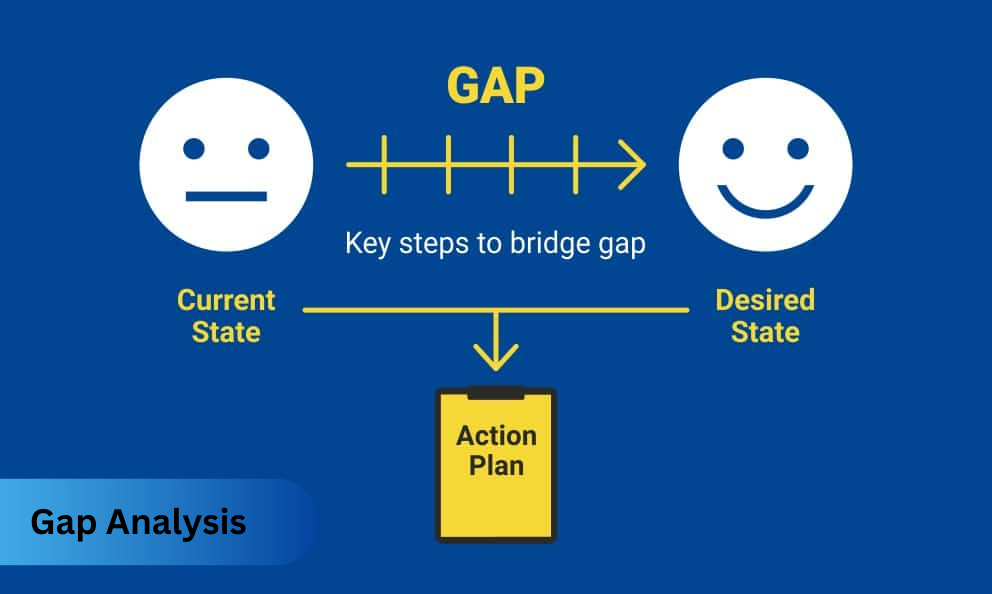In today’s fast-paced business environment, staying competitive means constantly evolving. But how do you know where to focus your efforts for the greatest impact? That’s where gap analysis comes in. Far more than just a buzzword, gap analysis is a powerful tool that helps organizations clearly identify the difference between where they are and where they want to be.
Whether you’re looking to improve performance, streamline operations, or align your strategy with long-term goals, understanding these “gaps” is the first step toward meaningful, strategic change.
In this post, we’ll explore how gap analysis can uncover hidden opportunities, sharpen your strategic vision, and ultimately drive transformation across your organization.
What Is Gap Analysis?
Gap analysis is a powerful tool that helps organizations identify the difference between their current performance and their desired outcomes. By assessing where you are versus where you want to be, you can uncover specific areas needing improvement.
This process not only highlights weaknesses but also reveals untapped opportunities for growth. When you understand these gaps, you can prioritize initiatives that drive strategic change in your organization.
Moreover, gap analysis fosters a culture of continuous improvement. It encourages teams to regularly assess their progress and adjust strategies accordingly. This proactive approach ensures that your organization remains agile in a constantly changing market.
By embracing gap analysis, leaders can make informed decisions that align resources with strategic goals, ultimately driving success and sustainability in the long run. In this way, gap analysis isn’t just about identifying problems — it’s about paving the way for innovative solutions and enhanced organizational performance.
Types of Business Gaps
Before starting a gap analysis, it’s important to clarify what you’re looking to uncover. There are two main types of gaps to consider: performance gaps and opportunity gaps.
Performance Gaps
Performance gaps are often the most visible type of business gap, manifesting as discrepancies between actual performance and desired outcomes. These gaps can stem from various sources, including inefficient processes, lack of employee training, or inadequate resources.
By conducting a thorough gap analysis, organizations can identify these performance discrepancies and implement targeted strategies to bridge them. This process not only enhances productivity but also boosts employee morale, as teams see tangible improvements in their work environment.
Opportunity Gaps
Opportunity gaps are subtler yet equally critical. They represent areas where a business could expand its market reach, enhance product offerings, or innovate its services but has not yet taken action. Identifying these gaps requires a keen understanding of market trends and customer needs.
By leveraging gap analysis, companies can uncover hidden opportunities and pivot strategically to seize them. Embracing this approach allows organizations to stay ahead of competitors and foster sustainable growth, ensuring they are not just reacting to current challenges but proactively shaping their future.
Key Components of a Gap Analysis
Before conducting a gap analysis, you need to begin with your current state. From there, you can evaluate your company’s strengths, weaknesses, limitations, and potential.
Define Your Current and Desired States
Defining current and desired states is vital for gap analysis. The current state reflects existing processes, resources, and performance, requiring an honest assessment to identify challenges. In contrast, the desired state represents success, such as improved efficiency or customer satisfaction, serving as a motivational benchmark. Identifying discrepancies between these states is essential; critical questions about obstacles and missing skills or technologies must be addressed.
This reflective process reveals improvement areas and encourages innovative solutions. Ultimately, clearly defining both states enables the creation of actionable steps to bridge the gap and achieve goals effectively.
Identify the Gap
Identifying the gap is a crucial step in understanding where an organization stands versus where it wants to be. One of the key components of a gap analysis is assessing current performance against desired outcomes. This involves not only looking at metrics but also gathering insights from team members and stakeholders. Their perspectives can reveal blind spots that data alone might miss, making the analysis richer and more comprehensive.
Another important aspect is recognizing both tangible and intangible gaps. While some gaps are easily quantifiable, such as sales figures or production timelines, others may reside in areas like employee morale or customer satisfaction. By expanding the focus beyond mere numbers, organizations can uncover deeper issues that affect overall success. This holistic view can lead to innovative solutions that address underlying problems rather than just symptoms, ultimately driving sustainable growth.
Collect Data
Collecting data is essential for identifying gaps within an organization, involving surveys, interviews, and metrics. This process reveals deficiencies and hidden improvement opportunities. Qualitative data complements quantitative metrics, offering insights from employees and customers that numbers alone may overlook.
Feedback from open-ended questions can illuminate issues like morale and satisfaction, enriching analysis. Additionally, leveraging technology such as data analytics software streamlines data collection, helping to identify trends and patterns efficiently. This capability enhances accuracy and saves time, making effective data analysis a vital asset for organizations seeking growth and improvement.
Conduct Root Cause Analysis
Conducting a root cause analysis is like being a detective in your own business. It involves digging deep to uncover the underlying issues that may be causing persistent problems or inefficiencies. By focusing on the key components of a gap analysis, you can identify what is happening, why it’s happening, and what needs to change. This process often reveals surprising insights, allowing teams to address not just symptoms but the actual causes of their challenges.
The “5 Whys” technique helps identify core issues by asking “why” repeatedly. Fishbone diagrams visually organize potential causes, facilitating teamwork in brainstorming solutions. Engaging diverse perspectives enriches discussions and fosters a culture of continuous improvement. Root cause analysis resolves current problems and prevents future ones, turning challenges into growth opportunities.
Develop an Action Plan
Developing an action plan is a crucial step in bridging the gap between your current state and desired outcomes. At the heart of this process lies a thorough understanding of the key components of a gap analysis.
This involves identifying specific goals, assessing existing resources, and pinpointing the obstacles that hinder progress. By clearly defining these elements, you can create a roadmap that not only highlights what needs to be done but also sets realistic timelines for achieving each milestone.
Moreover, it’s essential to involve stakeholders in this stage. Their insights can provide valuable perspectives on potential challenges and opportunities. Collaboration fosters accountability, ensuring that everyone is on board and committed to the plan’s success.
Regularly revisiting and adjusting the action plan based on feedback and changing circumstances is also vital. This dynamic approach transforms your initial strategy into a living document that evolves, allowing you to navigate the complexities of implementation with agility and confidence.
Increase Your Organization’s Potential
Gap analysis is a strategic tool that identifies discrepancies between current performance and goals, revealing opportunities for growth. It focuses on transforming weaknesses into actionable strategies that align with the organization’s vision.
Implementing gap analysis promotes continuous improvement and boosts team engagement. Regular reviews keep your organization agile, enhance efficiency, and empower innovation, driving strategic change and organizational growth.
Related Content: https://bizzleaders.com/team-leadership-training/
FAQs
Why Is It Important To Conduct A Gap Analysis?
A gap analysis encourages your organization to assess the gap between where you are and where you want to be, and helps you develop a structured action plan to close that gap. A gap analysis is also a powerful tool in strategic planning, and acts as an analysis on the performance of your organization in the past.
What Is The 5 Why Gap Analysis?
The 5 whys analysis is a problem-solving technique used to identify the root cause of an issue by asking “why” five times (or as many times as needed) to dig deeper into the cause-and-effect chain. Sakichi Toyoda originally developed it and it is widely used in lean and Six Sigma methodologies.
What Is The Main Goal Of Gap Analysis?
A gap analysis helps a company assess its current state—by measuring time, money, and labor—and compare it with its target state. By defining and analyzing the gaps between expectation and reality, the management team can move the organization forward and fill in the performance gaps.
When Should Gap Analysis Be Performed?
Conduct gap analyses on a regular basis, before a period of strategic planning, or whenever a department or venture is underperforming. A gap analysis is often a key part of strategic planning, which is a process that helps an organization define a strategy to accomplish its goals.

